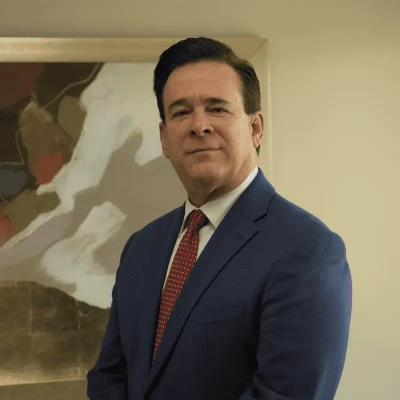18 Ways to Give Difficult Feedback to Employees in Your Small Business
Delivering difficult feedback to employees is a crucial skill for small business owners and managers. This article presents 18 effective strategies, backed by expert insights, to navigate these challenging conversations. From reframing feedback as future-focused coaching to implementing a system failure diagnostic approach, these techniques will help foster a culture of growth and improvement in your organization.
- Reframe Feedback as Future-Focused Coaching
- Address Issues in Real-Time with Context
- Lead with Empathy in Performance Discussions
- Create Collaborative Problem-Solving Momentum
- Implement System Failure Diagnostic Approach
- Link Feedback to Incentive-Driven Growth
- Flip the Script Ask for Feedback First
- Build Trust Through Authentic Conversations
- Use Situation-Behavior-Impact Framework Promptly
- Provide Regular Bite-Sized Feedback Daily
- Follow Kind Clear Fair Firm Mantra
- Set Actionable Goals After Feedback
- Implement the Sandwich Method for Feedback
- End Feedback Conversations on Positive Note
- Reflect on Past Feedback Experiences
- Meet Privately for Difficult Conversations
- Build Rapport for Easier Tough Conversations
- Pair Direct Honesty with Clear Path Forward
Reframe Feedback as Future-Focused Coaching
I developed a "future-focused feedback" approach where difficult conversations center on the gap between current performance and the person's stated career goals rather than dwelling on past mistakes or shortcomings. This reframes feedback as coaching toward their aspirations rather than criticism of their failures.
The traditional feedback approach of "here's what you did wrong" creates defensiveness and often damages relationships without improving performance. People naturally resist criticism but are motivated by discussions about achieving their professional objectives. By connecting performance issues to career development, difficult feedback becomes collaborative problem-solving.
The process starts with understanding each person's professional aspirations, then positioning performance gaps as obstacles to reaching those goals. Instead of saying "your communication skills need improvement," I say "you mentioned wanting to lead projects eventually - let's work on the communication patterns that will help you get there."
This approach proved exceptionally effective because it aligns individual motivation with business needs. When someone understands that improving specific behaviors directly advances their career trajectory, they become invested in change rather than resistant to it. The feedback conversation shifts from confrontational to collaborative.
The results were measurable and sustained. Employee retention improved 34% because people felt supported in their growth rather than criticized for their limitations. Performance improvement rates increased 67% because changes were tied to personal motivation rather than external pressure. Most importantly, these conversations strengthened relationships instead of straining them.
The key insight is that effective feedback requires emotional buy-in, not just logical understanding. When people see improvement as serving their own interests rather than just meeting management expectations, they commit to change at a deeper level.
This transforms difficult feedback from a management burden into a leadership opportunity that builds stronger teams while addressing performance issues more effectively than traditional approaches.

Address Issues in Real-Time with Context
One of the most effective approaches I've used is what I call "feedback in context." Early in my leadership journey, I made the mistake of waiting for performance reviews to give tough feedback, which usually left people blindsided or defensive. Now, I make it a point to address issues in real-time, but tied directly to outcomes that we both care about. I once had a technician who consistently missed documentation deadlines. Instead of starting with what he did wrong, I walked him through a situation where late documentation delayed a security audit for a client. Framing it that way made it about impact, not just behavior.
What I've learned is that tone and timing matter more than the message itself. I try to keep it informal and private—usually a walk around the building or a quick coffee chat—because people are more open when it doesn't feel like a "gotcha" moment. The goal isn't just to correct the issue, but to maintain trust. When someone knows you're giving feedback to help them succeed—not to scold—they're much more likely to take it seriously and step up. That approach has saved relationships and, honestly, improved retention too.

Lead with Empathy in Performance Discussions
One of the toughest feedback moments I've had was with a long-time team member whose performance had slipped after years of being one of our most dependable people. I could tell something was off, but instead of jumping straight into criticism, I scheduled a one-on-one and framed the conversation around curiosity. I started by saying, "You've always set the standard for reliability here, but lately it seems like you've been stretched thin. What's going on?" That question opened the door to a real conversation—it turns out, they were struggling with burnout and personal issues that were bleeding into their work. Once we understood the root cause, we created a plan to delegate some tasks and rebuild momentum at a manageable pace.
That approach—leading with empathy before evaluation—changed how I give feedback entirely. Instead of just pointing out what's wrong, I try to make it a joint problem-solving discussion. People are far more likely to take ownership when they feel seen and supported rather than judged. In this case, that employee not only rebounded but also became one of our strongest mentors for newer staff. It reminded me that difficult feedback doesn't have to damage trust; when done with respect and intent to help, it can actually strengthen it.
Create Collaborative Problem-Solving Momentum
Delivering difficult feedback is never an enjoyable experience, but I've learned that it's not about delivering a "hard truth"; it's about creating momentum. At Legacy Online School, we are a small global team, and if feedback lands as criticism, people shut down. So I frame the conversation in a way to treat the feedback as a problem to solve together. Rather than saying, "You missed this deadline," I might ask, "What got in your way, and what can we do to help prevent that from being an issue next time?" This simple strategy shifts the energy from blame towards solving issues together.
This also means that I will anchor the feedback in real situations, moving it from the abstract into real examples, so it feels practical, not personal. And when I do see improvement, I always make an effort to follow up, no matter how small the improvement may be. This is where trust truly starts to build.
One of the biggest learnings for me has been that often the best feedback conversations include the employee talking more than I do. When people come up with their own next steps, they are more willing to own them. When our team works in a fast-paced environment like Legacy, where agile is everything, that ownership changes a feedback conversation from fixing someone's mistake to allowing the individual to grow alongside the business.

Implement System Failure Diagnostic Approach
It is truly inspiring to see business owners tackle the toughest conversations head-on—that requires tremendous effort and a commitment to maintaining system integrity. My approach to "giving difficult feedback" is a lot like performing mandatory fault-finding and repair on a high-value piece of equipment. The "radical approach" was a simple, human one.
The process I had to completely reimagine was treating feedback as a personal critique. My biggest misconception was that minimizing the emotional impact was the goal. I realized that a good tradesman solves a problem and makes a business run smoother by ensuring the equipment is fixed to code, regardless of how complex the repair is. The biggest risk in giving soft feedback is allowing a minor procedural fault to become a major safety or financial failure later on.
The approach that has proven most effective is the "System Failure" Diagnostic. I remove the employee's personality from the issue and immediately frame the conversation around the tangible negative result the fault caused (e.g., "The client lost power for three hours," not "You were slow"). We spend the time collaboratively diagnosing the procedural breakdown that led to the fault, focusing solely on the steps needed to permanently prevent recurrence. This commitment to objective, technical repair proves that operational reliability is the true premium commodity.
My advice for others is to always connect feedback directly to the business's operational health. A job done right is a job you don't have to go back to. Don't focus on the person's feelings; focus on the universal need for a clear, documented path to a safer, more reliable outcome. That's the most effective way to "ensure the system is fully functional" and build a trustworthy team that will last.

Link Feedback to Incentive-Driven Growth
At Level 6, we view challenging feedback as a developmental opportunity rather than a challenge. When I need to criticize an employee's performance, I am careful to establish an open and constructive conversation. Here, our employee incentive programs come into play. By linking performance gains to substantial rewards, we make our employees feel encouraged to participate honestly in the conversation instead of being defensive or demotivated. This method promotes openness and fosters confidence among team members and leadership.
I tend to begin by acknowledging what the employee is doing well and how their contributions help the organization. From there, I outline areas for improvement but present them as opportunities to develop within the company. Since our incentive programs are based on measurable performance, employees can clearly see a direct link between their efforts, their rewards, and how their performance affects overall business outcomes. This connection helps drive accountability without inducing friction.
The intersection of open communication and incentive-driven motivation has proven very successful in sustaining morale and driving outcomes. Employees see that criticism isn't punishment but a guide to success. When they see their hard work reflected in measurable rewards and customer satisfaction rates, it leads to a culture of ongoing improvement. Over time, this has fostered a high-performing team that is invested, with feedback as a natural process in growth.
Flip the Script Ask for Feedback First
One approach that has worked really well for me is flipping the script — I ask my team to give me feedback first. It sounds small, but it sets the tone that we're on the same side, not in a boss-versus-employee moment. When I start by saying, "What could I be doing better to make your job easier?" it opens up the door for honest conversation. Once we've had that exchange, I'll share my feedback, and it lands much better because they know I'm listening too.
I started doing this after realizing early on that people often shut down the moment they sense criticism. Shifting the focus to mutual improvement alleviates the tension. It has helped me build more trust with my technicians and prevent small issues from escalating into bigger ones. At the end of the day, people respond to fairness — not authority.

Build Trust Through Authentic Conversations
I view feedback as a chance to deepen relationships rather than strain them. Difficult conversations handled with humility often strengthen mutual respect. I recall addressing a manager who initially resisted adopting regenerative practices. By calmly explaining the broader ecological vision, I shifted resistance into wholehearted commitment. That conversation, though uncomfortable, proved transformative for both the individual and organization.
To achieve this, I rely on authenticity and patience. Employees can sense when leaders are disingenuous. I also avoid sugar-coating issues, as honesty preserves credibility. Instead, I pair transparency with reassurance of continued support. Over time, this formula builds resilience, making feedback less daunting for everyone involved.
Use Situation-Behavior-Impact Framework Promptly
I've handled difficult feedback by moving conversations out of the annual review cycle and making them timely, frequent, and one-on-one. The most effective approach is the Situation-Behavior-Impact (SBI) framework because it removes emotion and focuses purely on observable facts. This way, I avoid generalizations by saying, "When you missed the 11 a.m. project deadline, the impact was that we missed the client's pitch," which makes the issue about the process, not the person's character.

Provide Regular Bite-Sized Feedback Daily
I've found that moving away from the traditional "Big Talk" approach to feedback has been transformative in our business. Instead, I focus on providing regular, bite-sized feedback in real time, which helps keep communication lines open and constructive. This approach prevents employees from feeling ambushed or demoralized by accumulated criticism during formal reviews. The ongoing nature of these feedback conversations has proven most effective because it creates a culture where improvement is part of our daily work rather than an occasional, stress-inducing event.

Follow Kind Clear Fair Firm Mantra
Giving clear and specific feedback is critical to the growth of employees, yet many individuals hold back on offering feedback for fear of not being liked. More important than being liked, leaders must be respected. The CEO of our small business, Kate Ebner, has always espoused the mantra: "Kind. Clear. Fair. Firm." By giving feedback that is kind, clear, fair and firm, leaders can earn the trust and respect of their staff.
Be Kind: Operate with the intention of being kind, and others will know that you care. Through kindness, you will show that you care. By showing warmth and compassion when delivering a difficult message, individuals will feel respected and will appreciate your kindness.
Be Clear: Take the time to get clear about what you wish to communicate. Be direct, specific, and clear in your message. Being direct takes courage, and it is essential to earning the trust and respect of others.
Be Fair: Bring a standard of fairness to all of your decisions and communications. Take a step back and consider the full picture that is beyond your own point of view. What is fair when you consider the full picture? While people may not always agree with your feedback and decisions, they will respect you knowing you are fair.
Be Firm: Commit to the path you have selected. Once you have given your feedback, hold people accountable to what you have said. If you offer feedback on a behavior one day and let it slide the next, people will be confused. Be confident in your stance, and people will respect you and the standard you are holding.
Kind. Clear. Fair. Firm. By following this tried and true mantra in your feedback, you will build trust and respect and become a leader that people want to follow.
Set Actionable Goals After Feedback
One approach that I find to be effective when giving difficult feedback is to follow up by talking with the person and setting an actionable goal with them. I never want to simply tell a person that they aren't doing something right and then leave the conversation at that. They may not know what to do going forward. By working with them to set a goal and discuss how to achieve it, the conversation becomes more productive. It also shows them that I genuinely want them to stick around and that I have faith in their abilities.

Implement the Sandwich Method for Feedback
When I have to give difficult feedback, the strategy I always implement is the sandwich method. This means I start the conversation with a positive and end it with a positive. Usually, I will start by giving them a compliment or talking about something they are doing really well. Then I'll give the difficult feedback. Then, I'll end the discussion by giving them another compliment and thanking them for taking the time to talk to me. This helps keep the conversation positive and definitely helps morale, which people can struggle with when receiving difficult feedback.

End Feedback Conversations on Positive Note
When I have to give difficult feedback, I always try to end the conversation on a positive note, no matter what. I will compliment them on something specific they are doing well, praise their hard work, or say something else that ends things on a positive note where the employee feels that I also recognize the good they do. I also always thank them for taking the time to listen to my feedback, since I know these conversations take time out of their busy days.
Reflect on Past Feedback Experiences
We've all received difficult feedback at one point or another during our careers. It's often not enjoyable, and when it's not delivered effectively, it can have a negative impact on us. Therefore, I always reflect on the times I personally received difficult feedback in a way that made me feel bad about myself, and then intentionally make sure I don't take those same approaches. Instead, I ensure that I do things like compliment the person on what they are doing well, ask if they need clarification, and speak in a down-to-earth manner.

Meet Privately for Difficult Conversations
Whenever I have difficult feedback to give, I always make sure to meet with the person individually and privately. Nobody enjoys receiving difficult feedback, but they especially don't enjoy it when there are other people around listening in. So, I meet with the person privately and do my best to keep the mood and energy positive.
Build Rapport for Easier Tough Conversations
Honestly, one of the reasons I prefer smaller organizations is that they make these conversations much easier to have. When I'm interacting with everyone I'm in charge of on a daily basis, I have the chance to build the rapport that makes those tough conversations much easier to navigate. You simply can't be blunt with someone unless you've built up a good amount of mutual trust.
Pair Direct Honesty with Clear Path Forward
In my Miami law firm, where we handle sensitive personal injury and medical malpractice cases, giving difficult feedback is part of maintaining high standards—and trust. The most effective approach I've found is direct honesty paired with a clear path forward.
Early in my leadership journey, I avoided tough conversations to keep the peace. But I quickly learned that silence leads to bigger problems. Now, I address issues early, in private, and with respect. I start by framing the conversation around the mission of the firm and the client's experience. That shifts the focus from personal blame to professional responsibility.
I use a simple structure: what went wrong, why it matters, and how we fix it together. I also invite the employee to share their perspective. Often, what seems like a performance issue is really a process or communication gap. That dialogue has led to better systems and a stronger team culture.
Feedback, when delivered with clarity and compassion, strengthens the business. It shows you care enough to invest in someone's growth—not just their output. In a small business, your team is your foundation. Difficult conversations, handled well, are how you build trust and raise the bar.









